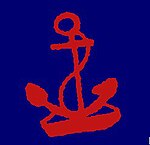Royal Australian Navy Bridging Train
| The Royal Australian Navy Bridging Train | |
|---|---|

Badge of the Royal Australian Navy Bridging Train
|
|
| Active | 24 February 1915 – May 1917 |
| Country |
|
| Branch |
|
| Type | Bridging Train |
| Role |
Logistical Support Combat Engineers Harbourmasters |
| Size | 9 Officers, 348 Other Ranks on embarkation at Melbourne (June 1915) |
| Part of |
Royal Australian Naval Brigade Attached to British Army IX Corps |
| Engagements |
First World War |
| Commanders | |
| Notable commanders |
Leighton Bracegirdle |
First World War
The Royal Australian Navy Bridging Train was a unique unit of the Royal Australian Navy. It was active only during the First World War, where it served in the Gallipoli and the Sinai and Palestine Campaigns. The Train was formed in February 1915 and stood down in May 1917. Throughout its existence, it was composed of Royal Australian Naval Reservists under the command of Lieutenant Commander Leighton Bracegirdle. Normally under the command of the British IX Corps, the Train also supported the I ANZAC Corps and Imperial Camel Corps in the defence of the Suez Canal.
They were the only Australian naval unit serving in a European theatre of war. They were therefore bent on proving, both to the Royal Navy and to the British Army, that they could overcome any difficulties.
The Train was Australia's most decorated naval unit of the First World War, with more than 20 decorations awarded to its sailors.
By 1915, with the prompt seizure of Germany's pacific possessions, it was becoming apparent that there would be very little for the Royal Australian Naval Brigade to do beyond securing Australia's ports. It was also becoming obvious that Trench Warfare was going to be the main feature of the Western Front, and that engineering units were in strong demand. Reports reached Australia that the even a Naval contingent would be acceptable, as the 63rd (Royal Naval) Division, consisting of Royal Marines and Naval Reservists, was preparing to join the Western Front.
...
Wikipedia
